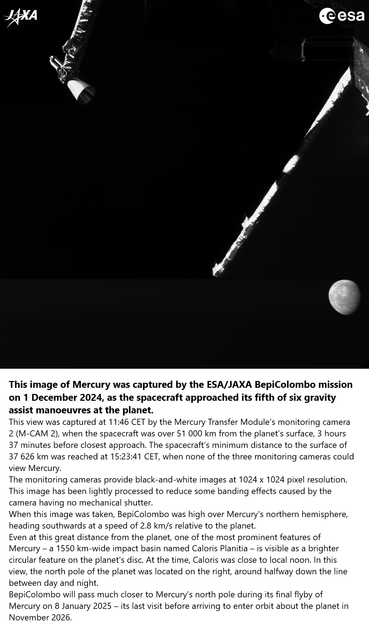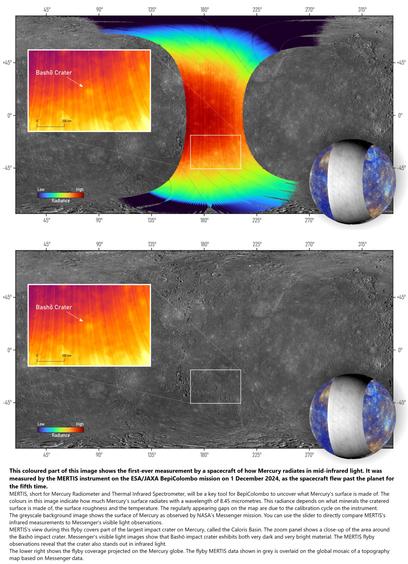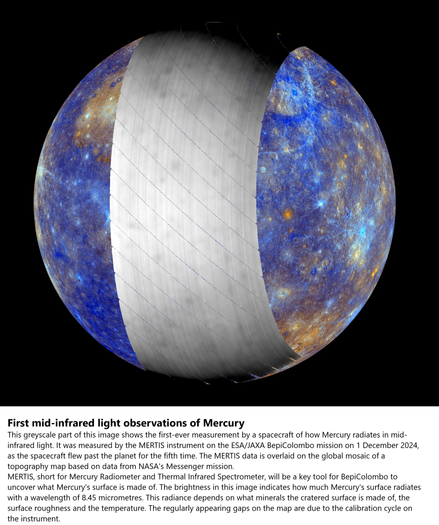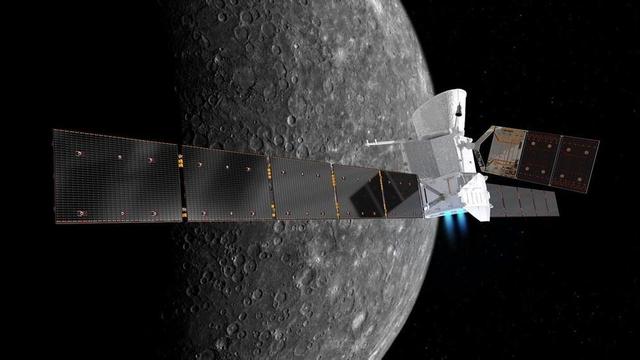BepiColombo [spacecraft] Reveals Mercury In A New Light [remote sensing]
--
https://www.esa.int/Science_Exploration/Space_Science/BepiColombo/BepiColombo_reveals_Mercury_in_a_new_light <-- ESA technical release
--
“On 1 December 2024, BepiColombo flew past Mercury for the fifth time. During this flyby, BepiColombo became the first spacecraft ever to observe Mercury in mid-infrared light..."
#GIS #spatial #mapping #remotesensing #astrogeology #geology #solarsystem #spacecraft #Mercury #BepiColombo #infrared #planet #geology #spatialanalysis #flyby #orbit #MERTIS
#MERTIS
[#BepiColombo survole #Mercure ...] Ce 1er décembre, la #sonde européano-japonaise s'est positionnée entre le #Soleil et la planète Mercure, recueillant un ensemble de données scientifiques - relatives notamment à sa #composition de surface.
Le survol d'une #planète, c'est l'occasion en effet pour les scientifiques des agences spatiales impliquées - ici l' ESA et la JAXA, d'allumer les #instruments embarqués, de vérifier leur bon fonctionnement, et de collecter de nouvelles données. Cette fois, ce sont des données relatives à la #température et la composition de surface de la planète Mercure qu'a recueillies l'instrument #MERTIS, un radiomètre et #spectromètre infrarouge thermique.
Une première ! Jamais en effet Mercure n'avait encore été observée dans ce domaine de longueurs d'ondes, l'IR moyen. Infos+ : https://www.esa.int/ESA_Multimedia/Images/2024/11/BepiColombo_s_fifth_Mercury_flyby
After almost 20 years, we are almost at #mercury : onboard #bepicolombo this sunday we will see mercury for the first time with #mertis !
https://www.esa.int/ESA_Multimedia/Images/2024/11/BepiColombo_s_fifth_Mercury_flyby
"WWU: Planetologe Harald Hiesinger über „BepiColombo“"
"„Im Weltraum ist bislang alles ohne größere Probleme verlaufen“. Eine Information der Westfälischen Wilhelms-Universität (WWU)."
https://www.raumfahrer.net/wwu-planetologe-harald-hiesinger-ueber-bepicolombo/
#BepiColombo #DLR #ESA #HaraldHiesinger #JAXA #Merkur #MERTIS #Münster #Raumfahrt #Raumsonde #WWU
14.9.2023


![On Sunday 1 December 2024, BepiColombo will fly past planet Mercury for the fifth time, readying itself for entering orbit around the Solar System’s mysterious innermost planet in 2026.
The spacecraft will fly between Mercury and the Sun, getting to within 37 630 km from the small planet’s surface at 15:23 CET. This is much farther than its first four flybys of the planet, when BepiColombo flew as close as 165–240 km from the surface.
What makes this flyby special is that it will be the first time that BepiColombo’s MERTIS instrument is able to observe Mercury. This radiometer and thermal infrared spectrometer will measure how much the planet radiates in infrared light, something which depends on both the temperature and composition of the surface.
This will be the first time that any spacecraft measures what Mercury looks like in mid-infrared wavelengths of light (7–14 micrometres). The data that MERTIS will collect throughout the mission will reveal what types of minerals the planet’s surface is made of, one of the key Mercury mysteries that BepiColombo is designed to tackle...
[Image description: Infographic explaining BepiColombo’s fifth flyby of Mercury. In the centre of the graphic we see the spacecraft flying past the planet. On the left we see the inner Solar System in perspective, with the positions of Mercury, Venus and Earth indicated. On the right we see which of BepiColombo’s instruments will be activated during the flyby.]](https://files.mastodon.social/cache/media_attachments/files/113/625/402/944/866/882/small/0397f6a9ea1ad311.jpg)

